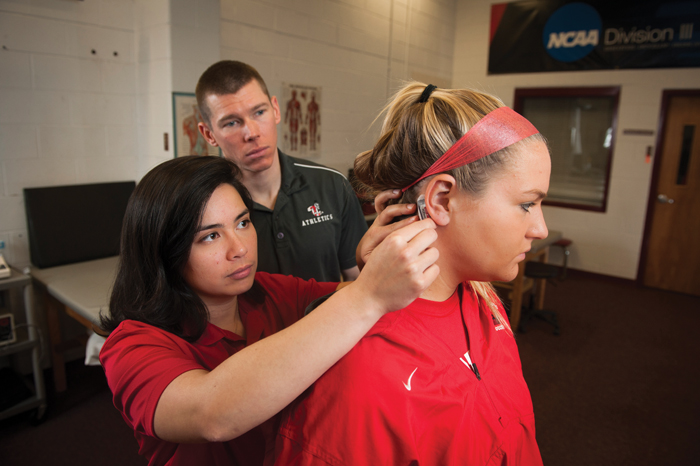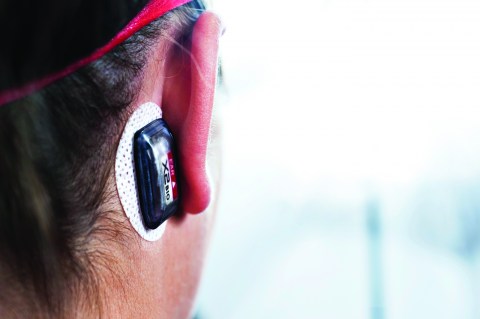Getting hit in the head during practices and games is part of being an athlete. It is common knowledge that really hard hits can cause concussions and other serious brain injuries.
Dr. Tom Bowman, associate professor of athletic training, and a group of students are researching the frequency and severity of impacts in men’s lacrosse and men’s and women’s soccer.
Dr. Bowman said one of the impacts they measured in men’s lacrosse team members last spring was “like driving your car into a tree at 40 miles per hour.”

Eleven male lacrosse players volunteered for the testing. The student researchers found that the men suffered 651 impacts per 1,000 exposures (practice or game). In other words, men can expect to get hit in the head 3.5 times for every five times they play.
More disturbing, the research showed that of 108 head impacts in games that should have drawn a penalty, only two were called, Dr. Bowman said. He hopes that findings like these may encourage referees to become stricter when enforcing rules.
Dr. Bowman said very little research has been done on head impacts outside of football, and to date, no research has been published on soccer. With the help of his students, he hopes to change that. “Division III has the highest rate of participation and the least research,” said Dr. Bowman, whose efforts to change that have been recognized by the Virginia Athletic Trainers’ Association (VATA), which named him the 2015 Athletic Trainer of the Year for Research.
“Our intention is to make sports safer. It’s what our careers are all about.”
Dr. Bowman admits he has some personal reservations about children’s exposures. “I played football for eight years growing up, but it will be a tough decision if my son wants to play,” he said.
After collecting data on men’s lacrosse last spring, athletic training majors Lydia Vollavanh ’15, Elizabeth Koehling ’15 and Kathleen O’Day ’15 analyzed the data, which included watching video of every practice and game to see how athletes were hit. The students are preparing several abstracts on the results of the men’s lacrosse survey to submit to the National Athletic Trainers’ Association with hopes of presenting their research at the national meeting in June.
 Athletes who agree to be part of the program have a sensor called an xPatch by X2 Biosystems hooked behind their ear. The xPatch contains a gyroscope that measures the “g” forces every time the head is hit. The hit can be head to head, head to body, head to stick or ball, or head to ground.
Athletes who agree to be part of the program have a sensor called an xPatch by X2 Biosystems hooked behind their ear. The xPatch contains a gyroscope that measures the “g” forces every time the head is hit. The hit can be head to head, head to body, head to stick or ball, or head to ground.
Lydia has been studying what is termed the impact of mechanism on the head, that is, what caused the hit to an athlete’s head. In the men’s lacrosse study, she found — not surprisingly — that the softest blow was when someone’s head hit a body as opposed to a stick, helmet or the ground.
A club soccer player, Lydia said the study has not changed her mind about participating in sports, nor would she discourage others, but she said knowledge is important. “People need to be aware of the dangers they’re putting themselves in,” she said.
Lydia, who aspires to work with professional soccer teams in England, said having the chance to do this level of research at the undergraduate level is amazing and that the LC athletic training program is top notch. “People don’t understand the impact our faculty have on the athletic training community as a whole,” she said.
Lacrosse player Austin Stewart ’16 says he doesn’t think he has had any severe blows to the head. “It is tough to describe the experience because it happens so fast and you get back up and keep playing so you don’t really have time to let that feeling soak in,” he said. “I have experienced a hazy green vision in the past when experiencing contact to the head that goes away almost instantly.
“My biggest fear is that the amount of contact in the sport of lacrosse is underestimated, and the helmets are not protective enough, and not nearly as protective as football helmets.”
He said the study makes him more aware of the dangers of head injuries within the sport, but he is hopeful that helmets become “more about safety and less about style in the future.”
Steve Koudelka, head coach for men’s lacrosse, said he is grateful for the research and also thinks improving men’s lacrosse helmets would be the most effective way to reduce head injuries. Soccer players, however, have no such option. “Concussion rates are higher for women than men in soccer,” Dr. Bowman noted, adding that he guesses that they probably get hit more often and report more often than men.
All-American soccer player Angela Bosco ’14 said the study has made her more aware of the trauma she has experienced. “Two years ago, I got a concussion in our game against Virginia Wesleyan,” she said. “All I remember was I was going up to head the ball and the next thing I knew I was on the floor. I was definitely not myself after I got hit; they had scored shortly after that and I had no idea where I was. I asked my coach to take me out because I was so confused and, sure enough, I had a concussion.
“I would say yeah, I am definitely a little concerned about blows to the head affecting me long term, even minor ones. It is pretty scary seeing the results of some of the hits that you experience during soccer.”
This article appeared in the Spring 2015 edition of the University of Lynchburg Magazine. For more content from this issue, visit http://www.lynchburg.edu/spring2015

